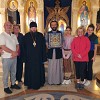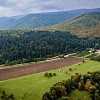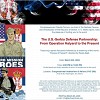Viewing the “Anatomy of Oblivion” Exhibit
On Thursday, January 26, 2023, the Saint Sava Serbian Eastern Orthodox Church of McKeesport, PA, hosted a public presentation and discussion surrounding the “Anatomy of Oblivion” exhibit, which details the horrific events which took place at the Jasenovac concentration camp, located within the borders of Croatia, during WW II. The traveling exhibit was produced by the National and University Library of the Republic of Srpska, and sponsored by the Serbian National Federation and The Department of Christian Education of the Serbian Orthodox Diocese of Eastern America. The exhibit is comprised of 11 large posters which pictorially and textually describe the many crimes committed against humanity at Jasenovac, and delves into the human-interest stories surrounding the victims and lays bare the sheer barbarism practiced by the Ustaše perpetrators of these crimes.
The Saint Sava parish was honored to have 40 high school students, plus several teachers from the local McKeesport high school attend the presentation, along with 5 other students who are studying world history as part of their home-schooling curriculum. Parishioners from St. Sava who were interested in learning more about Jasenovac also attended. Since many of the students were anticipated to be unfamiliar with Balkan history, Serbian culture and migrations, and the distinction between Eastern Orthodoxy and Roman Catholicism, it was felt that an introduction to these topics was necessary to provide the context necessary for the students to properly interpret and comprehend the Jasenovac saga. Therefore, Michael Mochan, a Saint Sava Church-School teacher, prepared a 35-minute-long Microsoft PowerPoint slide-show and presented it to the group prior to them actually viewing the exhibit posters.
Like the exhibit posters, the slide-show included graphic images of some of the atrocities that took place at Jasenovac, and the student’s teachers were provided with advance notice of the disturbing nature of the presentation prior to the student’s arrival. The teachers determined that the students were sufficiently mature to view the material, and all parties agreed that it was, in fact, necessary to see the unfiltered images to bring the true nature and extent of the suffering of the victims to full conscious awareness and realization in the minds of the students. In short, these images are disturbing and the normal human psyche should interpret them that way if we are ever to fathom the extent of evil that can be inflicted upon one group by another.
One of the goals of the slide-show was to point out the salient objectives of the exhibit, starting with understanding the thrust of the meaning of the exhibit’s title, specifically, the use of the word oblivion, which Webster’s Dictionary defines as: “The condition or state of being forgotten or unknown.” A major portion of the presentation was then aimed at describing why it is important that the events that happened at Jasenovac not be forgotten. To succinctly drive home this point, the famous quote from the American philosopher George Santayana was cited: “Those who forget history are condemned to repeat it.”
One of the concerns in presenting the exhibit to the students was to be truthful and factual while remaining cognizant of the sensitivities of students regarding the challenges it might present to their own religious convictions and ethnicities. Leaving the young students with a feeling of guilt by association was clearly something to be avoided. For instance, we knew that some of the students followed the Roman Catholic faith and that the Ustaše had unequivocally been abetted in the commission of their crimes by Roman Catholic clergy. We addressed this issue by pointing out that no blanket claim of wrong doing was being leveled against ALL clergy and practitioners of Catholicism. Instead, the presentation focused on those Catholic clergy (associated with Jasenovac) who had perverted the fundamental tenets of Christianity, for instance, in clear disregard of the “golden rule” by engaging in clericalism. Pope Francis’s definition of clericalism (delivered to the Synod Fathers at Synod 2018) was provided to explain the nature of the perversion of clerical behavior (regardless of the religion in which it occurs). It reads as follows:
“Clericalism arises from an elitist and exclusivist vision of vocation, that interprets the ministry received as a power to be exercised rather than as a free and generous service to be given. This leads us to believe that we belong to a group that has all the answers and no longer needs to listen or learn anything. Clericalism is a perversion and is the root of many evils in the Church: we must humbly ask forgiveness for this and above all create the conditions so that it is not repeated.”
The slide show also delved into the history of the Southern Slavic people, specifically, the migrations of the Serbian and Croatian peoples from the Carpathian Mountains to their present locations in the Balkans. Defining moments in Christian history were also presented to show how the division between Roman Catholicism and Eastern Orthodoxy arose following the great schism in 1054. The invasion and long occupation by the Ottomans that prompted the migration of Serbians into the Krajina region of present-day Croatia at the behest of the Hapsburgs was explained. The causes of WW I and the ensuing formation of Yugoslavia in its aftermath, which set the conditions for the birth of the fascist Ustaše party and atrocities at Jasenovac were elaborated. Thus, the students were able to view the exhibit with a basic understanding of the root causes of the evil calamities which befell the Serbians, Roma, and Jews.
After the students toured the exhibit, they returned to view the remainder of the slide-show which focused on basic psychological aspects that might offer some explanation of how human beings could inflict such inhuman treatment upon others. Various psychological conditions were discussed, including: personality disorders (sadism, sociopathic, etc.), ideological indoctrination, the by-stander affect, fear of reprisal, and Milgram’s obedience experiments. Finally, an explanation regarding the presence of evil in the world (both then and now) was put forward.
The remaining time of the presentation was used for an open question and answer session, which was led by our Very Rev. Stavrophor Stevan Rocknage. The topic of forgiveness of one’s oppressor was raised along with a discussion of what the students had learned and how they thought future catastrophes like Jasenovac could be avoided. Following the closure of the presentation, the teachers provided very positive remarks regarding their impressions and overall satisfaction with the presentation and exhibits. In turn, the St. Sava representatives thanked the students and teachers for their attendance and taking the time to learn about Jasenovac so they may be better prepared to recognize and stand up against oppression and injustice in the future.
|
| |||||||||||||







